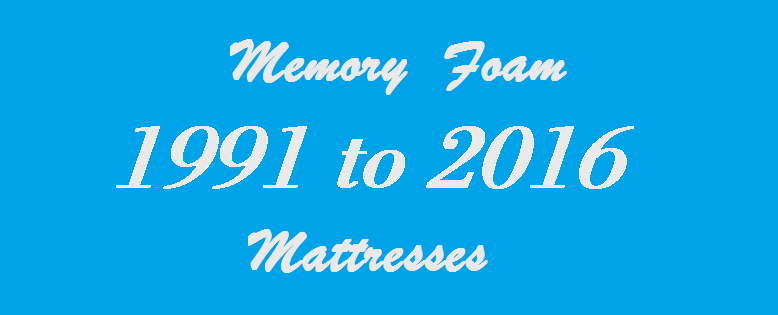
The Introduction: Memory Foam Mattresses
2016 marks a quarter century since memory foam mattresses were introduced into the bedding market. It did not take long for this new innovation to change the mattress industry. Now specialty sleep mattresses (those without metal coils) command a large share of the market, and most of these are memory foam mattresses or have memory foam among their materials.
It took much longer for metal coils to dominate mattress sales. Credit for inventing the innerspring mattress is attributed to Heinrich Westphal in 1871, but they were not produced until later. Later, Bonnell coils were developed by Louis Andrew Vargha from buggy seat springs. Adoption of coil beds was slow until after the end of World War II, when most mattresses purchased had innersprings. By this time, several kinds of innerspring coils had been introduced. Besides Bonnell coils, pocket coils were invented by James Marshall in 1900, offset coils by Francis Karr in 1926, and continuous coils by Serta.
In the 1950s, foam mattresses were introduced by Firestone’s polyurethane foam mattress, followed by foam rubber (now called “latex foam“) mattresses. They only made a small dent in sales of innerspring mattresses.
Memory foam had its origin in the US space program. In the 1960s, NASA commissioned the development of seating foam that would conform to astronauts’ bodies to relieve pressure during launches. This was polyurethane foam with additives to make it both denser and more heat sensitive. The high density made it less pressure sensitive and more supportive (elastic). But being heat sensitive, it became softer (viscous) when warmed, allowing the body to sink in. This made it conform to the shape of the body, which meant that the body was evenly supported without undue pressure on any one point. One of the inventors labeled it “temper foam” because of its temperature sensitivity, and the name stuck.
In the 1980s, NASA released their conforming foam for commercial development and consumer use. The company which pursued this successfully was Fagerdala, a Swedish firm, and its Danish subsidiary Dan Foam. The resulting product was called “Tempur” – a variation of “temper.”
By 1991, Fagerdala World Foam was ready. They introduced the Swedish Tempur bed, the first memory foam mattress, made of Tempur Material. It quickly became popular because of its pressure-relief. The next year, Tempur-Pedic was incorporated in the United States to sell this new mattress, which became popular in this country also.
If the sincerest form of flattery is imitation, the Swedish Tempur Material is well-flattered, for it has become widely imitated. In fact, Tempur-Pedic mattresses are still the standard by which all other memory foam mattresses are evaluated.
In the 25 years since the first memory foam mattress appeared on the market, there have been many developments in the use of memory foam in mattresses.
Changes were made in the way memory foam is formulated and processed to address the issue of overheating. Since it is temperature sensitive, memory foam naturally accumulates heat. And since it is dense, it does not easily cool. Two solutions have been making the cells more open (open-cell configuration) to make the foam itself more breathable, and ventilation with holes molded into the foam or punched through it to increase airflow. This is used in TempFlow products as part of their patented AirFlow Transfer System, which also channels the flow of air to and from the sides of the mattress.
Memory foam also tends to be clingy, cradling, and slow to respond. This is due to its temperature sensitivity. This combined issue is addressed by multi-layered construction, using different densities of memory foam together, such as the design of Tri-Pedic mattresses, which has influenced memory foam mattress design of other companies, including Tempur-Pedic. This allows the memory foam to conform more quickly at cool room temperatures and respond more quickly to a sleeper’s change of position.
Memory foam is also being combined with other mattress constructions and materials. This includes comfort layers in innerspring mattresses, waterbeds, air beds, and latex mattresses, creating a class of mattresses called hybrids. Some memory foam mattresses now have microcoils.
Since its introduction a quarter century ago, it is evident that memory foam mattresses and hybrids are here to stay. Memory foam mattresses are dominant in the current mattress-in-a-box trend, which is changing the way mattresses are marketed. Not only are new companies selling these compressible, boxed beds, but established firms are joining with brands such as the Cocoon by Sealy and the Snuggle-Pedic Mattress made by Relief-Mart. They have come a long way from the first visco-elastic Swedish Tempur mattress in 1991, and will continue to develop and improve.

